Tomorrow’s jobs demand a highly trained workforce. Job seekers across North Carolina are entering a dynamic economy that requires new sets of technical skills and the ability to navigate increasing uncertainty. Once powered by industries like farming and manufacturing, North Carolina’s economy continues to shift toward a knowledge- and service-based economy comprised of higher-skilled jobs. Existing lower-skilled, lower-wage jobs are at increasing risk of being replaced by a machine or a computer algorithm.
A highly trained workforce is a key driver of economic growth. Employers are drawn to regions where they can easily hire and retain skilled employees, and communities benefit substantially when new industries move to town or existing companies grow. More-educated workers are less likely to be unemployed and more likely to earn higher family-supporting wages.1 In addition, increased educational attainment is a powerful predictor of adult well-being, including better physical and mental health outcomes, more stable relationships, and greater civic knowledge and engagement. Adults’ educational attainment is also a key predictor of their children’s own level of education and wages.2
These trends are having a profound impact on the value we place on postsecondary schooling. The fastest-growing sectors of North Carolina’s economy demand employees with increasingly higher levels of educational attainment. By 2020, an estimated 67% of all jobs in North Carolina will require some education and training beyond high school.3 Today, 47% of North Carolina’s 5.3 million working-age adults (25-64 years old) have a postsecondary degree or nondegree credential.4
To meet the projected demands for an educated workforce, at least 60% of NC workers will need a postsecondary degree or nondegree credential by 2030. To reach 60% attainment today, an additional 672,000 NC adults would need to obtain a postsecondary degree or nondegree credential.
Changing Economic Landscape
One of the main drivers of increased demand for educated workers is that the fastest-growing jobs require more education, and there are concerns that the US is not producing enough talent to fully support the demand for workers in certain sectors.5
In North Carolina, the number of jobs is projected to grow more quickly in the coming decade than the working-age population.6 The number of jobs statewide is projected to increase by 389,000, or 8.3%, between 2017 and 2026, according to the most recent projections from the Labor and Economic Analysis Division at the NC Department of Commerce. Nearly a quarter of these new jobs will be in the health care and social assistance industry. Among occupational groups, health care support staff is projected to grow the fastest at 1.9% annually, followed by computer and mathematical occupations, personal care and service occupations, and health care practitioners and technical occupations.7

The fastest-growing jobs require a postsecondary degree or nondegree credential (Figure 1). Jobs requiring a high school diploma or less are projected to grow by 6.8%, while jobs requiring some college but no degree will grow at just 5.3%, slower than the overall growth rate of 8.3%. By contrast, the growth of jobs requiring a nondegree credential or postsecondary degree is projected to outpace total job growth. The largest projected increases between 2017 and 2026 are for jobs that require a master’s degree or more (12.4%) or jobs that require an associate degree (11.6%).
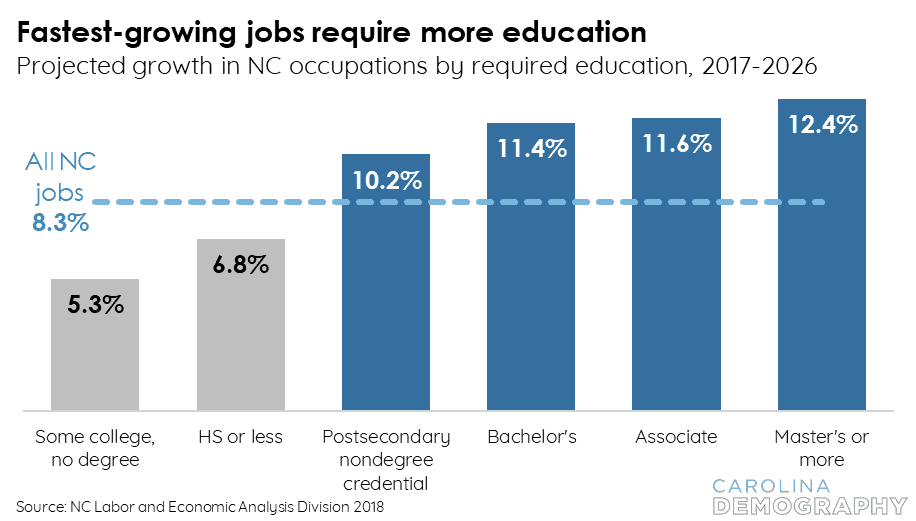
Changing Demographic Landscape
While North Carolina’s economy is evolving, its population is growing older and substantially more diverse. Many adult residents entered the workforce at a time when a high school diploma was enough to earn a family-supporting wage. As more baby boomers choose to remain in the workforce beyond typical retirement age, some may discover that they are not adequately trained for the jobs of the twenty-first-century economy. Many of these individuals may need to return to school as adults to obtain new skills or credentials.
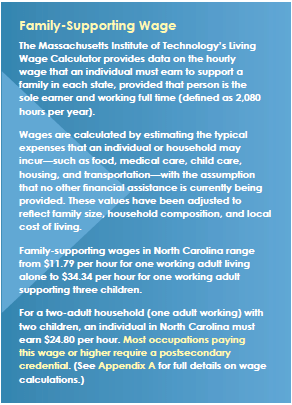
The diversification of North Carolina’s population is similarly recent. Since 2000, North Carolina’s Hispanic and Asian populations have more than doubled.8 As in the nation as a whole, diversity in North Carolina is greatest among the youngest members of the population. During the 2015-16 school year, for the first time more than half of the state’s public school students identified as Black (26%), Hispanic (17%), Asian (3%), American Indian (1%), or multiracial (4%).9 (Please see the Glossary for definitions of these racial/ethnic groups). During this same year, more than half of K-12 students (52% or 749,000) were eligible for free or reduced-price lunch.10 Minority and low-income students have traditionally been underrepresented in our state’s higher education system, yet they now constitute the majority of those enrolled in North Carolina‘s public school system.
Current Attainment Landscape
As of 2016, less than half of North Carolina’s 5.3 million working-age adults aged 25-64 (47% or 2.5 million) had completed a postsecondary degree or nondegree credential (Figure 2). Specifically:
- 42%, or 2.2 million, hold an associate degree or more:
- 10%, or 550,000, have an associate degree
- 21%, or 1.1 million, have a bachelor’s degree
- 11%, or 590,000, have a master’s degree or more, and
- 5%, or 260,000, do not have a degree but have completed a nondegree credential.11
Among adults without a postsecondary degree or nondegree credential, the largest share (24% or 1.3 million) have a high school diploma or equivalency, followed by adults with some college but no degree or credential (17% or 905,000) and adults with less than a high school diploma (11% or 605,000).

North Carolina’s rising educational attainment driven by in-migration
Over the past forty years, the educational attainment of North Carolina’s workforce steadily increased. In 1980, North Carolina’s educational attainment lagged the national average: 23% of adults aged 25-64 had an associate degree or higher, six percentage points lower than the nationwide share (29%). By 2000, this gap had narrowed to two percentage points. In 2016, the share of NC adults with an associate degree or higher surpassed the national rate for the first time (42.5% vs. 41.7%).
North Carolina’s rising educational attainment has been driven by the net in-migration of highly educated individuals from other states and countries. Between 1990 and 2016, the state’s population of working-age adults (25-64) with an associate degree or higher grew by 1.3 million; 930,000 of these individuals were born in another state or country. While 42% of all NC working-age adults have an associate degree or higher, this proportion is 50% among individuals born in another state or country and just 35% among North Carolina born adults.12
Educational attainment varies across the state
Educational attainment varies significantly across geographic and demographic subgroups. In addition to the wide gaps in attainment between North Carolina-born adults and those born in other states or countries, there are wide gaps between women and men, between urban and rural places, and across race and ethnicity.
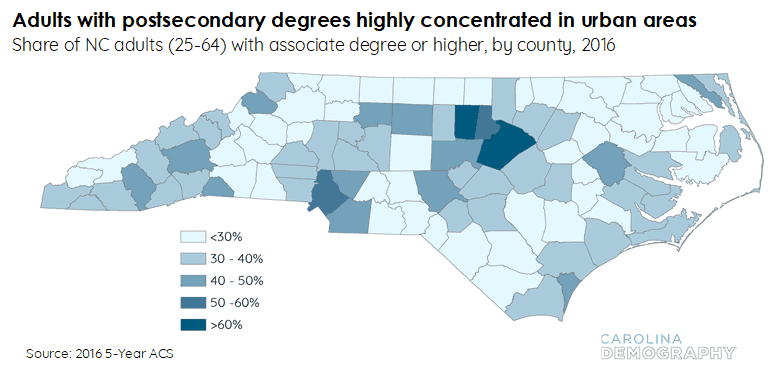
The state’s highly educated adult population is heavily concentrated in the Triangle region (Raleigh, Durham, and Chapel Hill) and Charlotte (Figure 3). With 66% of adults reporting an associate degree or higher, Orange County has the highest postsecondary attainment rate of any NC county, followed by Wake (61%), Durham (55%), and Mecklenburg (53%) counties. These are the only four counties where more than half of adults aged 25-64 have an associate degree or higher. Another nine counties have adult attainment rates that exceed the state average of 42% but are less than 50%; most of these counties are home to a major urban area, a large research institution, or both. In the remaining eighty-seven NC counties, fewer than 42% of adults have an associate degree or higher. In five counties, the postsecondary degree attainment rate is below 20%, with Tyrrell County (13%) having the lowest adult attainment rate of any county in the state.13
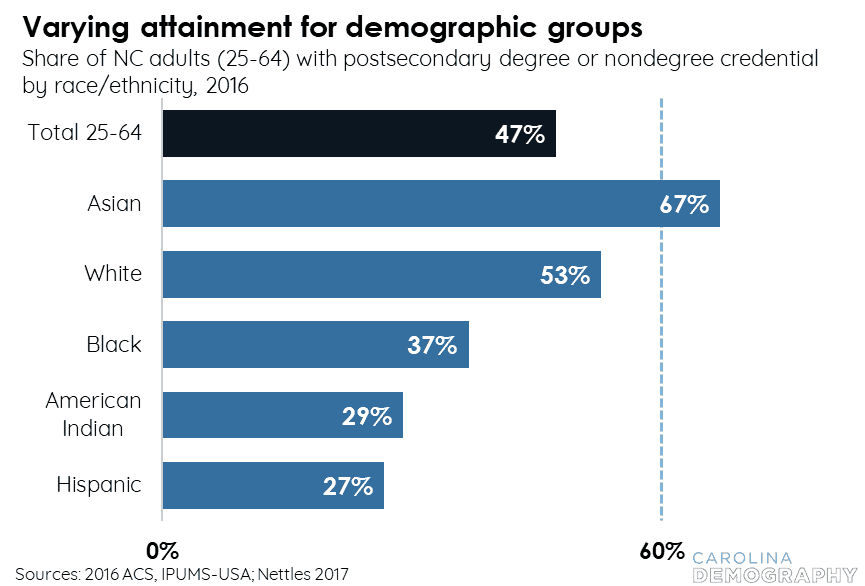
Among racial and ethnic subgroups, 67% of North Carolina’s Asian working age adults held a postsecondary degree or nondegree credential in 2016 (Figure 4). White adults were the only other group where more than half (53%) had achieved a postsecondary degree or nondegree credential.
Our state’s Black (37%), American Indian (29%), and Hispanic (27%) populations are much less likely to report holding a postsecondary degree or nondegree credential.14
Hispanic adults reported the lowest levels of educational attainment in 2016. This largely reflects the fact that North Carolina’s adult Hispanic population is currently dominated by first-generation immigrants who have relatively lower levels of schooling. As the US-born children of these immigrants—the second generation—ages into adulthood, we should expect the proportion of Hispanic adults with postsecondary degrees and nondegree credentials to increase.
Current trends are insufficient to reach future demands
The share of North Carolina’s population with a postsecondary degree or nondegree credential increased from 40% in 2006 to 47% in 2016, again of seven percentage points in ten years.15 These gains were due to two major factors:
- Generational replacement, in which younger, more educated generations replaced older, less educated cohorts in the workforce
- Net in-migration of highly educated individuals. North Carolina has been a magnet for highly educated workers, and this has fueled much of the state’s rising educational attainment16
Together, these factors will continue to increase attainment in the coming years, but the recent improvements are not enough for the state to reach at least 60% attainment by 2030.
By 2030, the share of NC adults with a postsecondary degree or nondegree credential is projected to increase nine percentage points, from 47% to 56% (Figure 5; detailed data and methodology in Appendix C). An additional 253,000 individuals would need to complete a postsecondary degree or nondegree credential for the state to reach at least 60% attainment.
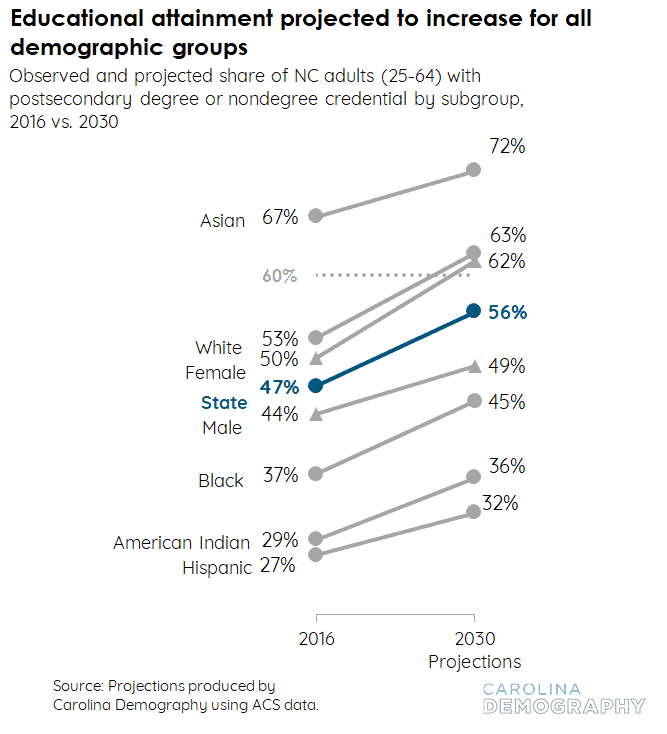
Disparities in attainment are projected to persist and widen over this time. Three of North Carolina’s demographic groups are projected to have attainment exceeding 60% by 2030: Asian (72%), White (63%), and female (62%) adults. For all other groups—male (49%), Black (45%), American Indian (36%), and Hispanic (32%)—fewer than half of working-age adults are projected to have a postsecondary degree or nondegree credential by 2030. Recent research from the Educational Testing Service (ETS) on national progress toward 60% attainment finds that three of our nation’s racial/ethnic minority groups—American Indian, Black, and Hispanic—are projected to fall far short of the attainment goal, even as late as 2060.
In North Carolina, as in the nation at large, “[e]xtraordinary attention and innovation are needed for the […] overall population and its underserved populations to reach the […] postsecondary attainment goals.”17
NC must eliminate barriers to opportunity to reach 60% and beyond
These economic and demographic realities reiterate the importance of eliminating barriers to opportunity for all who call North Carolina home. If we are to meet the demands of tomorrow’s job market, all North Carolinians must be able to realize the promise of education, particularly nontraditional students, minority and low-income students, rural students, and others who are disproportionately affected by challenges associated with postsecondary access and completion.
Rather than rely on attracting highly educated individuals from other states and countries to increase our state’s attainment, we can strengthen our ability to cultivate our own talent. While it is important that the state remain an attractive place for highly educated individuals—as this indicates that North Carolina has a large pool of potential employers and a high quality of life—a strategy of importing talent to meet the 60% goal is not viable long-term. It also fails to effectively prepare our citizens and communities for social mobility and economic success. Now is the time for our state and its communities and institutions to work together to strengthen the pathways to and through postsecondary education so that North Carolinians can develop their talent, obtain meaningful work, and accelerate their upward economic mobility.
To make change, we must first understand the landscape of the state. Together, Carolina Demography and the John M. Belk Endowment developed a data-driven understanding of North Carolina’s educational pipeline and potential pathways to 60% adult educational attainment.
Editor’s note: The Belk Endowment supports the work of EducationNC. To read the full report and view the data, visit ncedpipeline.org.



